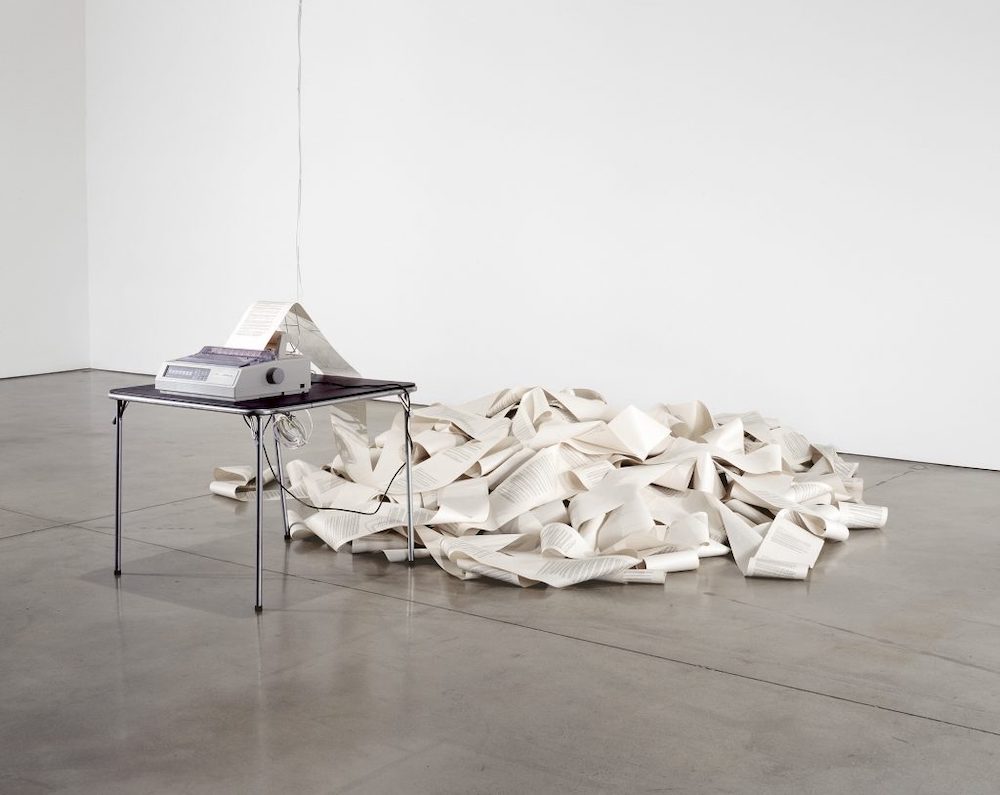With Artificial Intelligence, or AI, on everyone’s mind, it seems pertinent to go back in time to 1952 and think about a pre-digital world, a time before the personal computer, cell phones and social media. The exhibition “Coded: Art Enters the Computer Age, 1952-1982,” conceived and curated by LACMA’s Leslie Jones, harkens back to this era, showcasing early experiments in graphic arts, conceptual art and art made with primitive computers. The works span from the creation of the first purely aesthetic image made on a computer to the replacement of the main frame by the personal computer. While terms like mathematics, generative and informational appear often in the exhibition, Jones’ keen awareness of aesthetics has led to a show not about information, but of stunning artworks influenced by and created with the aid of available technologies of the time.
The exhibition features paintings, sculptures, drawings, and projections that weave through the different ways artists were experimenting with what was new and inspiring. In the first room, viewers see Edward Kienholz’ The Friendly Grey Computer—Star Gauge Model #54 (1965) and Lowell Nesbitt’s I.B.M. Disc Pack (1965)—neither of which are works that use technology. Kienholz’s piece is an assemblage made from industrial parts, while Nesbitt’s is a hyperrealistic large-scale painting of I.B. M. disc. As the show progresses, Jones juxtaposes art output by plotters, like Frederick Hammersley’s Computer Drawings (1969), with more conceptual by artists like Sol LeWitt who created hand-made pieces that followed specific algorithms. Examples of Minimal and Op art are shown alongside generative patterned works created on computers by artists like Vera Molnar, as well as Colette Stuebe Bangert and Charles Jeffries Bangert. As Hans Haacke’s News (1969)—a telex machine that prints headlines from newswires in real-time—endlessly spews text printed on ever-flowing rolls of paper that spill onto the gallery floor, one can’t help but think of how things have changed from when getting news in real time was not available to the general public.
An underlying theme in the exhibition is how artists work with code and think about motion and movement. Pausing to watch one of the video and film works—be it Sheila Pinkel’s Intuition (1977) or Stan VanDerBeek’s Poemfield No. 1 (Blue Version) (1967) or Permutations (1968) by John Whitney Sr.—takes viewers both back in time, but also forward as they compare current high-tech animations with the inventive low-tech experiments on display.
While Jones relies on a specific trajectory through the exhibition, the takeaway is about the relationship between now and then: how ideas are generated, what inspires artists, and how they use what is available—be it paint, pencil, words or a snippet of code. The process of creation from inception to execution is what drives these artists, and with all the talk of AI, it is interesting to ponder the process and whether AI (now in its infancy) will transcend the evils that surround it in much the same way art made with computers or code has come to be appreciated, respected and valued today.
“Coded: Art Enters the Computer Age, 1952-1982” poses and answers questions that are as relevant now as they were then. It is doubtful that in 1952, or even in 1982, one could have predicted that most everyone would carry a small computer in their pocket and be globally connected at all times. Whether this is a good or bad thing is up to each of us. Regardless, the ways technology has inspired creativity continue to grow.



















0 Comments